ICT310: System Analysis and Design Report Task 2, ATMC Semester 2
VerifiedAdded on 2023/06/04
|18
|3387
|216
Report
AI Summary
This report provides a detailed analysis and design of a system, exploring various methodologies such as Adaptive System Development, Extreme Programming, Rapid Application Development, Agile Software Development, Waterfall Model, Spiral Model, and Dynamic System Development. It justifies the use of Agile System Methodology for a specific case study, discusses Human Computer Interface (HCI) design principles, and includes a memo outlining design considerations. The report also features use case modeling with an event table, use case diagram, and use case descriptions, as well as domain modeling with class diagrams. It also includes a discussion on the Human Computer Interface (HCI) design approaches such as Empirical Approach and Predictive Modelling Approach.

SYSTEM ANALYSIS AND DESIGN 1
System Analysis and Design
Student Name
Institutional Affiliation
System Analysis and Design
Student Name
Institutional Affiliation
Paraphrase This Document
Need a fresh take? Get an instant paraphrase of this document with our AI Paraphraser
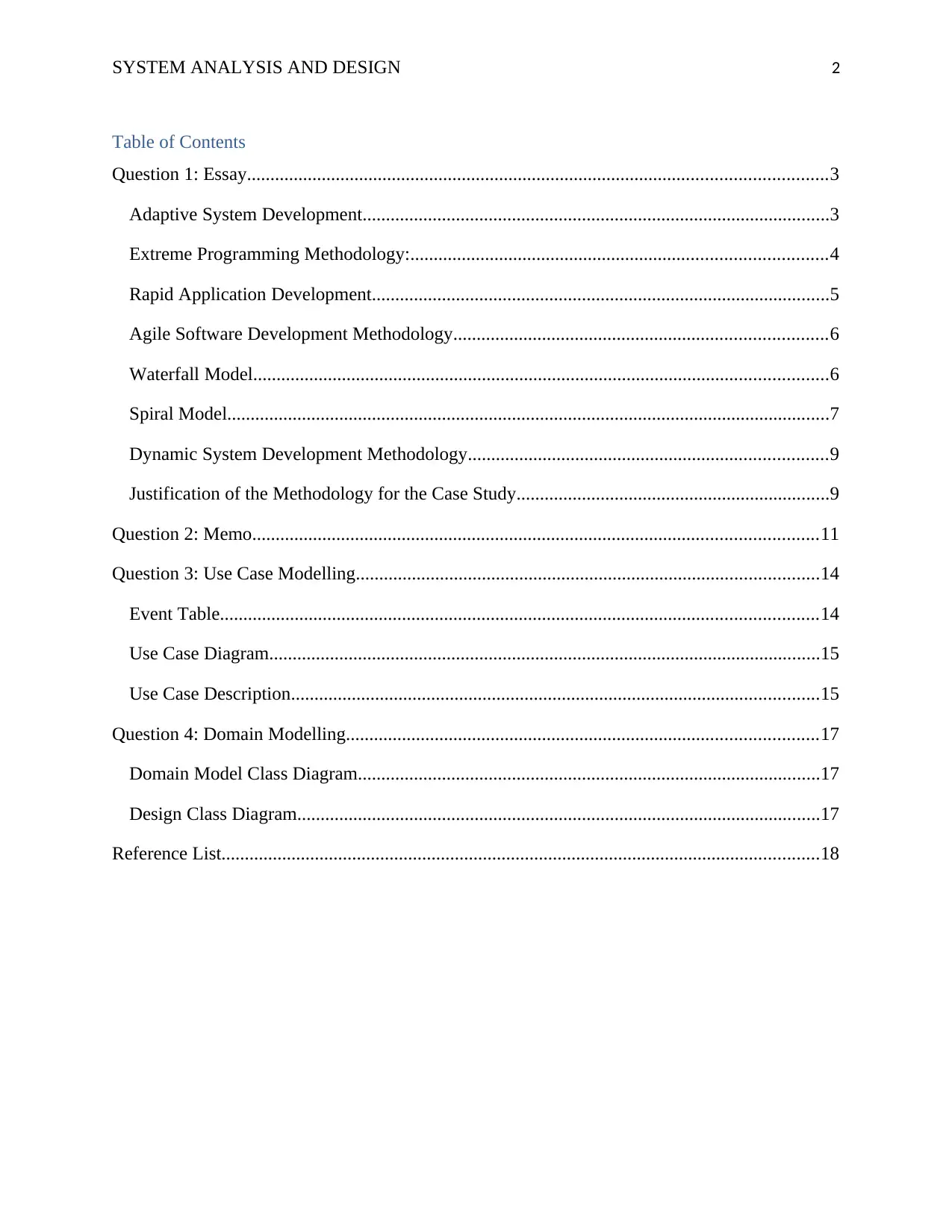
SYSTEM ANALYSIS AND DESIGN 2
Table of Contents
Question 1: Essay............................................................................................................................3
Adaptive System Development....................................................................................................3
Extreme Programming Methodology:.........................................................................................4
Rapid Application Development..................................................................................................5
Agile Software Development Methodology................................................................................6
Waterfall Model...........................................................................................................................6
Spiral Model.................................................................................................................................7
Dynamic System Development Methodology.............................................................................9
Justification of the Methodology for the Case Study...................................................................9
Question 2: Memo.........................................................................................................................11
Question 3: Use Case Modelling...................................................................................................14
Event Table................................................................................................................................14
Use Case Diagram......................................................................................................................15
Use Case Description.................................................................................................................15
Question 4: Domain Modelling.....................................................................................................17
Domain Model Class Diagram...................................................................................................17
Design Class Diagram................................................................................................................17
Reference List................................................................................................................................18
Table of Contents
Question 1: Essay............................................................................................................................3
Adaptive System Development....................................................................................................3
Extreme Programming Methodology:.........................................................................................4
Rapid Application Development..................................................................................................5
Agile Software Development Methodology................................................................................6
Waterfall Model...........................................................................................................................6
Spiral Model.................................................................................................................................7
Dynamic System Development Methodology.............................................................................9
Justification of the Methodology for the Case Study...................................................................9
Question 2: Memo.........................................................................................................................11
Question 3: Use Case Modelling...................................................................................................14
Event Table................................................................................................................................14
Use Case Diagram......................................................................................................................15
Use Case Description.................................................................................................................15
Question 4: Domain Modelling.....................................................................................................17
Domain Model Class Diagram...................................................................................................17
Design Class Diagram................................................................................................................17
Reference List................................................................................................................................18
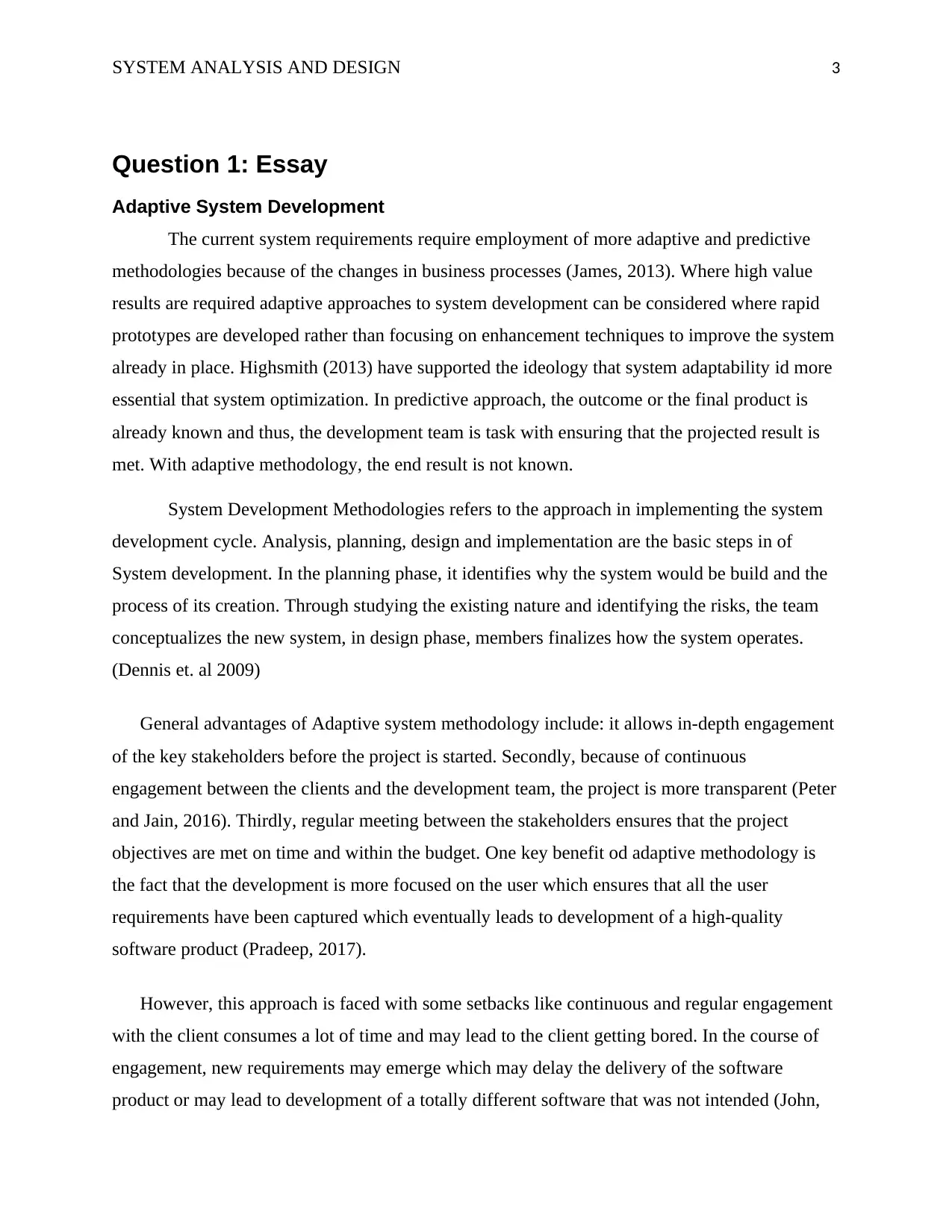
SYSTEM ANALYSIS AND DESIGN 3
Question 1: Essay
Adaptive System Development
The current system requirements require employment of more adaptive and predictive
methodologies because of the changes in business processes (James, 2013). Where high value
results are required adaptive approaches to system development can be considered where rapid
prototypes are developed rather than focusing on enhancement techniques to improve the system
already in place. Highsmith (2013) have supported the ideology that system adaptability id more
essential that system optimization. In predictive approach, the outcome or the final product is
already known and thus, the development team is task with ensuring that the projected result is
met. With adaptive methodology, the end result is not known.
System Development Methodologies refers to the approach in implementing the system
development cycle. Analysis, planning, design and implementation are the basic steps in of
System development. In the planning phase, it identifies why the system would be build and the
process of its creation. Through studying the existing nature and identifying the risks, the team
conceptualizes the new system, in design phase, members finalizes how the system operates.
(Dennis et. al 2009)
General advantages of Adaptive system methodology include: it allows in-depth engagement
of the key stakeholders before the project is started. Secondly, because of continuous
engagement between the clients and the development team, the project is more transparent (Peter
and Jain, 2016). Thirdly, regular meeting between the stakeholders ensures that the project
objectives are met on time and within the budget. One key benefit od adaptive methodology is
the fact that the development is more focused on the user which ensures that all the user
requirements have been captured which eventually leads to development of a high-quality
software product (Pradeep, 2017).
However, this approach is faced with some setbacks like continuous and regular engagement
with the client consumes a lot of time and may lead to the client getting bored. In the course of
engagement, new requirements may emerge which may delay the delivery of the software
product or may lead to development of a totally different software that was not intended (John,
Question 1: Essay
Adaptive System Development
The current system requirements require employment of more adaptive and predictive
methodologies because of the changes in business processes (James, 2013). Where high value
results are required adaptive approaches to system development can be considered where rapid
prototypes are developed rather than focusing on enhancement techniques to improve the system
already in place. Highsmith (2013) have supported the ideology that system adaptability id more
essential that system optimization. In predictive approach, the outcome or the final product is
already known and thus, the development team is task with ensuring that the projected result is
met. With adaptive methodology, the end result is not known.
System Development Methodologies refers to the approach in implementing the system
development cycle. Analysis, planning, design and implementation are the basic steps in of
System development. In the planning phase, it identifies why the system would be build and the
process of its creation. Through studying the existing nature and identifying the risks, the team
conceptualizes the new system, in design phase, members finalizes how the system operates.
(Dennis et. al 2009)
General advantages of Adaptive system methodology include: it allows in-depth engagement
of the key stakeholders before the project is started. Secondly, because of continuous
engagement between the clients and the development team, the project is more transparent (Peter
and Jain, 2016). Thirdly, regular meeting between the stakeholders ensures that the project
objectives are met on time and within the budget. One key benefit od adaptive methodology is
the fact that the development is more focused on the user which ensures that all the user
requirements have been captured which eventually leads to development of a high-quality
software product (Pradeep, 2017).
However, this approach is faced with some setbacks like continuous and regular engagement
with the client consumes a lot of time and may lead to the client getting bored. In the course of
engagement, new requirements may emerge which may delay the delivery of the software
product or may lead to development of a totally different software that was not intended (John,
⊘ This is a preview!⊘
Do you want full access?
Subscribe today to unlock all pages.

Trusted by 1+ million students worldwide
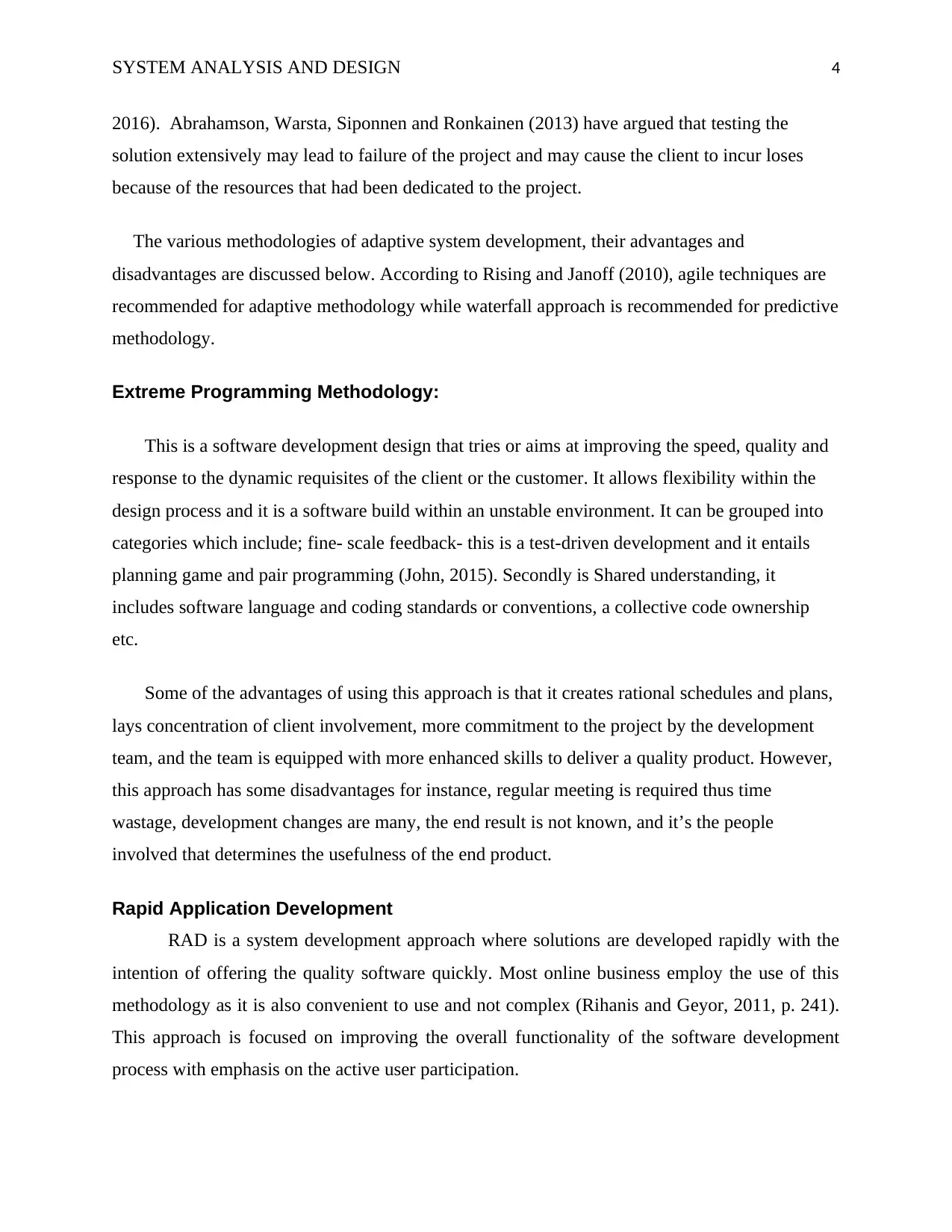
SYSTEM ANALYSIS AND DESIGN 4
2016). Abrahamson, Warsta, Siponnen and Ronkainen (2013) have argued that testing the
solution extensively may lead to failure of the project and may cause the client to incur loses
because of the resources that had been dedicated to the project.
The various methodologies of adaptive system development, their advantages and
disadvantages are discussed below. According to Rising and Janoff (2010), agile techniques are
recommended for adaptive methodology while waterfall approach is recommended for predictive
methodology.
Extreme Programming Methodology:
This is a software development design that tries or aims at improving the speed, quality and
response to the dynamic requisites of the client or the customer. It allows flexibility within the
design process and it is a software build within an unstable environment. It can be grouped into
categories which include; fine- scale feedback- this is a test-driven development and it entails
planning game and pair programming (John, 2015). Secondly is Shared understanding, it
includes software language and coding standards or conventions, a collective code ownership
etc.
Some of the advantages of using this approach is that it creates rational schedules and plans,
lays concentration of client involvement, more commitment to the project by the development
team, and the team is equipped with more enhanced skills to deliver a quality product. However,
this approach has some disadvantages for instance, regular meeting is required thus time
wastage, development changes are many, the end result is not known, and it’s the people
involved that determines the usefulness of the end product.
Rapid Application Development
RAD is a system development approach where solutions are developed rapidly with the
intention of offering the quality software quickly. Most online business employ the use of this
methodology as it is also convenient to use and not complex (Rihanis and Geyor, 2011, p. 241).
This approach is focused on improving the overall functionality of the software development
process with emphasis on the active user participation.
2016). Abrahamson, Warsta, Siponnen and Ronkainen (2013) have argued that testing the
solution extensively may lead to failure of the project and may cause the client to incur loses
because of the resources that had been dedicated to the project.
The various methodologies of adaptive system development, their advantages and
disadvantages are discussed below. According to Rising and Janoff (2010), agile techniques are
recommended for adaptive methodology while waterfall approach is recommended for predictive
methodology.
Extreme Programming Methodology:
This is a software development design that tries or aims at improving the speed, quality and
response to the dynamic requisites of the client or the customer. It allows flexibility within the
design process and it is a software build within an unstable environment. It can be grouped into
categories which include; fine- scale feedback- this is a test-driven development and it entails
planning game and pair programming (John, 2015). Secondly is Shared understanding, it
includes software language and coding standards or conventions, a collective code ownership
etc.
Some of the advantages of using this approach is that it creates rational schedules and plans,
lays concentration of client involvement, more commitment to the project by the development
team, and the team is equipped with more enhanced skills to deliver a quality product. However,
this approach has some disadvantages for instance, regular meeting is required thus time
wastage, development changes are many, the end result is not known, and it’s the people
involved that determines the usefulness of the end product.
Rapid Application Development
RAD is a system development approach where solutions are developed rapidly with the
intention of offering the quality software quickly. Most online business employ the use of this
methodology as it is also convenient to use and not complex (Rihanis and Geyor, 2011, p. 241).
This approach is focused on improving the overall functionality of the software development
process with emphasis on the active user participation.
Paraphrase This Document
Need a fresh take? Get an instant paraphrase of this document with our AI Paraphraser
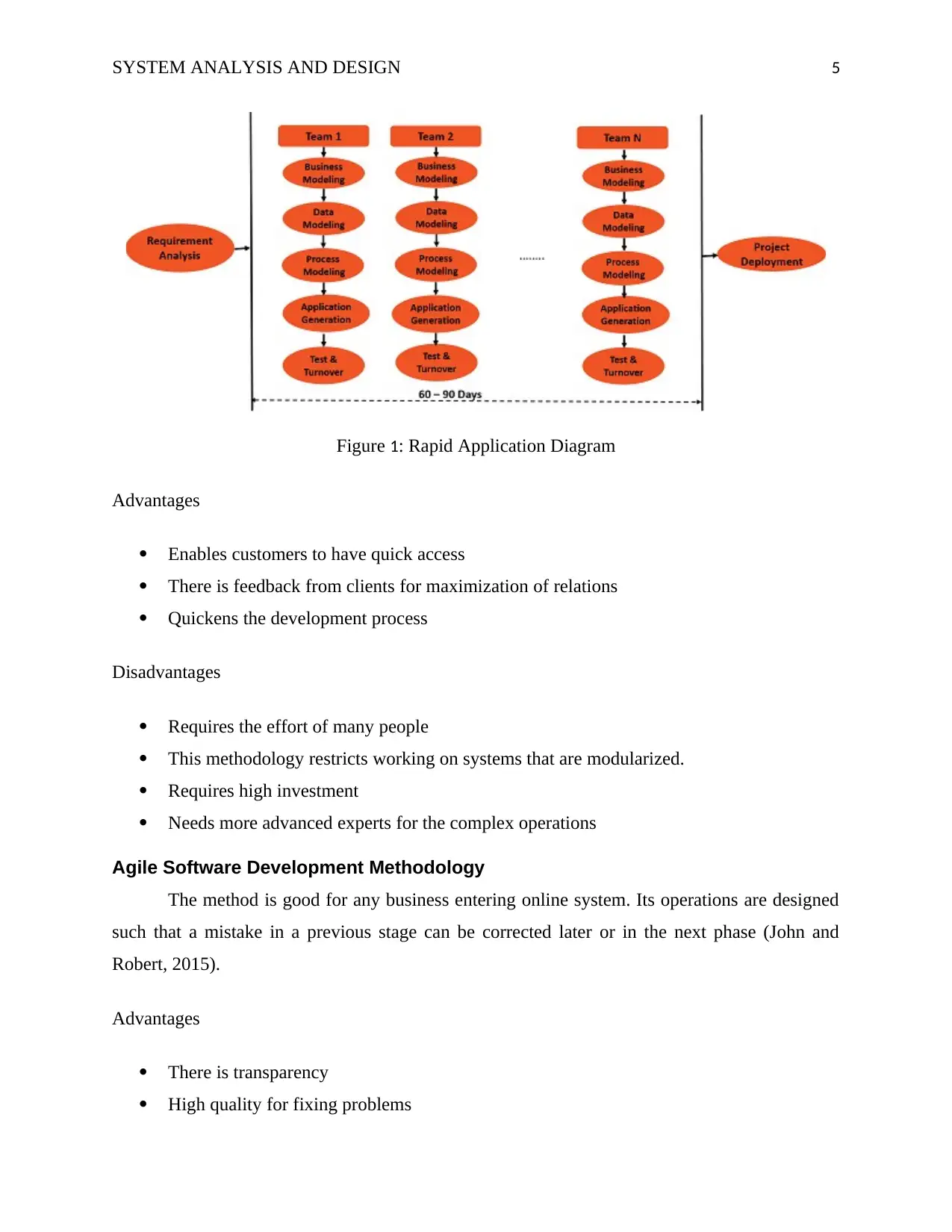
SYSTEM ANALYSIS AND DESIGN 5
Figure 1: Rapid Application Diagram
Advantages
Enables customers to have quick access
There is feedback from clients for maximization of relations
Quickens the development process
Disadvantages
Requires the effort of many people
This methodology restricts working on systems that are modularized.
Requires high investment
Needs more advanced experts for the complex operations
Agile Software Development Methodology
The method is good for any business entering online system. Its operations are designed
such that a mistake in a previous stage can be corrected later or in the next phase (John and
Robert, 2015).
Advantages
There is transparency
High quality for fixing problems
Figure 1: Rapid Application Diagram
Advantages
Enables customers to have quick access
There is feedback from clients for maximization of relations
Quickens the development process
Disadvantages
Requires the effort of many people
This methodology restricts working on systems that are modularized.
Requires high investment
Needs more advanced experts for the complex operations
Agile Software Development Methodology
The method is good for any business entering online system. Its operations are designed
such that a mistake in a previous stage can be corrected later or in the next phase (John and
Robert, 2015).
Advantages
There is transparency
High quality for fixing problems
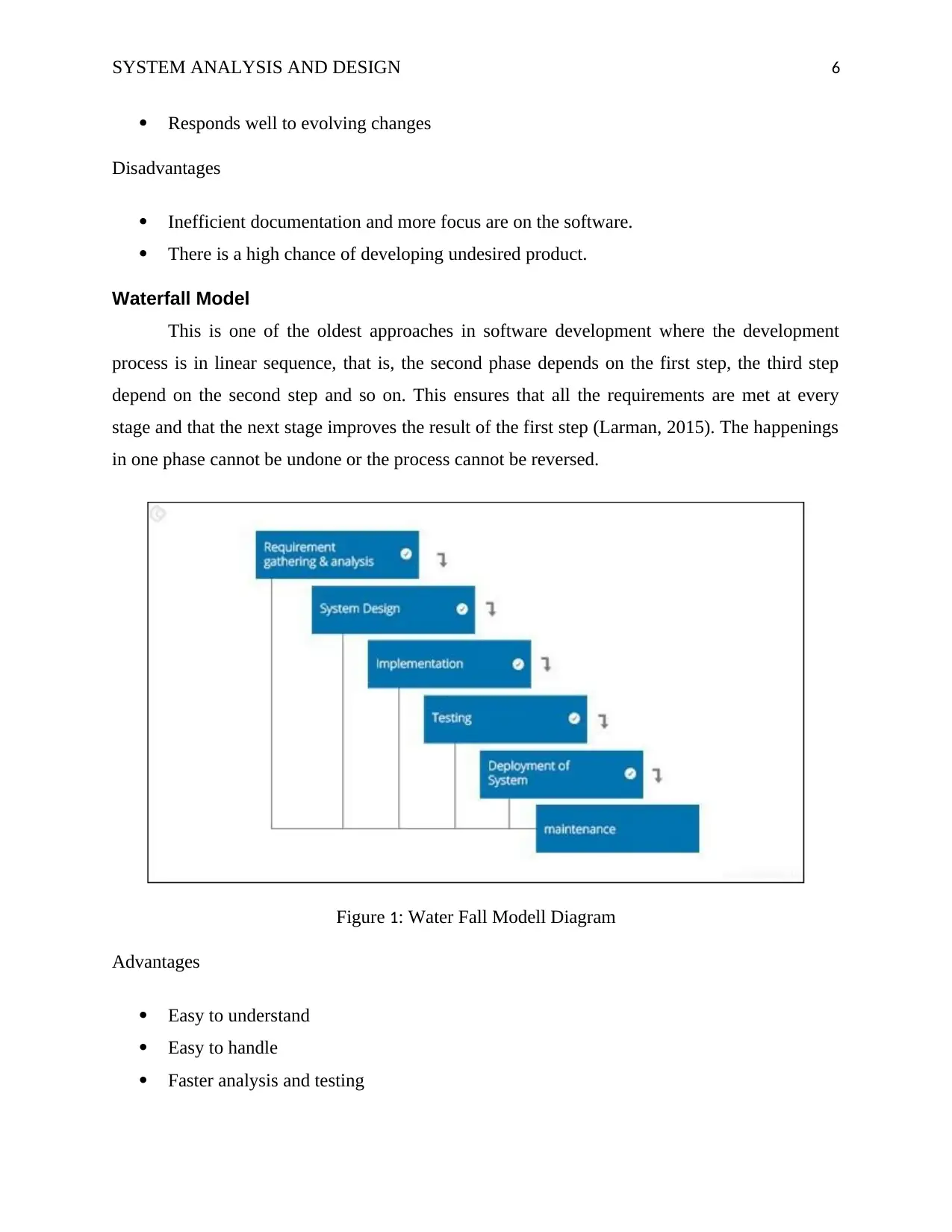
SYSTEM ANALYSIS AND DESIGN 6
Responds well to evolving changes
Disadvantages
Inefficient documentation and more focus are on the software.
There is a high chance of developing undesired product.
Waterfall Model
This is one of the oldest approaches in software development where the development
process is in linear sequence, that is, the second phase depends on the first step, the third step
depend on the second step and so on. This ensures that all the requirements are met at every
stage and that the next stage improves the result of the first step (Larman, 2015). The happenings
in one phase cannot be undone or the process cannot be reversed.
Figure 1: Water Fall Modell Diagram
Advantages
Easy to understand
Easy to handle
Faster analysis and testing
Responds well to evolving changes
Disadvantages
Inefficient documentation and more focus are on the software.
There is a high chance of developing undesired product.
Waterfall Model
This is one of the oldest approaches in software development where the development
process is in linear sequence, that is, the second phase depends on the first step, the third step
depend on the second step and so on. This ensures that all the requirements are met at every
stage and that the next stage improves the result of the first step (Larman, 2015). The happenings
in one phase cannot be undone or the process cannot be reversed.
Figure 1: Water Fall Modell Diagram
Advantages
Easy to understand
Easy to handle
Faster analysis and testing
⊘ This is a preview!⊘
Do you want full access?
Subscribe today to unlock all pages.

Trusted by 1+ million students worldwide
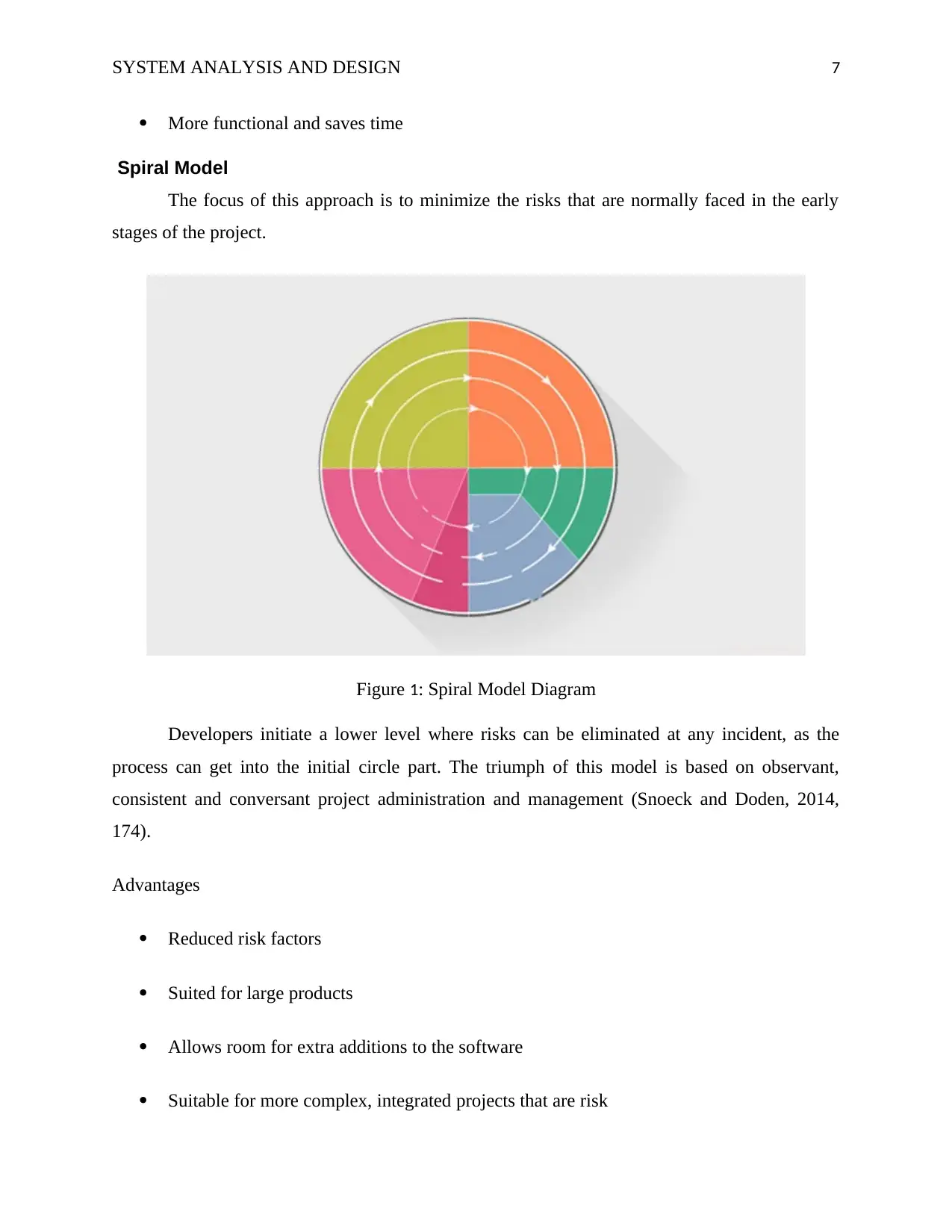
SYSTEM ANALYSIS AND DESIGN 7
More functional and saves time
Spiral Model
The focus of this approach is to minimize the risks that are normally faced in the early
stages of the project.
Figure 1: Spiral Model Diagram
Developers initiate a lower level where risks can be eliminated at any incident, as the
process can get into the initial circle part. The triumph of this model is based on observant,
consistent and conversant project administration and management (Snoeck and Doden, 2014,
174).
Advantages
Reduced risk factors
Suited for large products
Allows room for extra additions to the software
Suitable for more complex, integrated projects that are risk
More functional and saves time
Spiral Model
The focus of this approach is to minimize the risks that are normally faced in the early
stages of the project.
Figure 1: Spiral Model Diagram
Developers initiate a lower level where risks can be eliminated at any incident, as the
process can get into the initial circle part. The triumph of this model is based on observant,
consistent and conversant project administration and management (Snoeck and Doden, 2014,
174).
Advantages
Reduced risk factors
Suited for large products
Allows room for extra additions to the software
Suitable for more complex, integrated projects that are risk
Paraphrase This Document
Need a fresh take? Get an instant paraphrase of this document with our AI Paraphraser
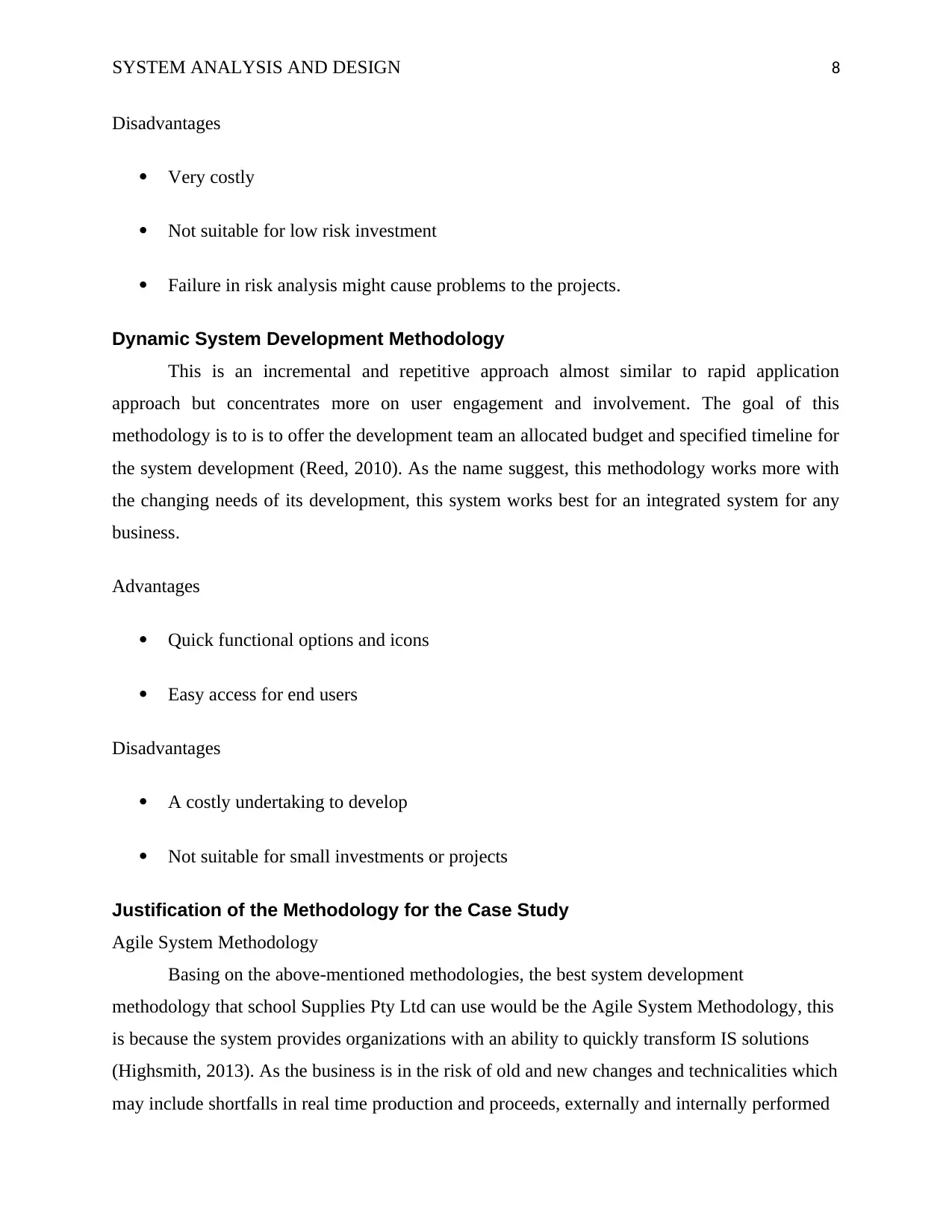
SYSTEM ANALYSIS AND DESIGN 8
Disadvantages
Very costly
Not suitable for low risk investment
Failure in risk analysis might cause problems to the projects.
Dynamic System Development Methodology
This is an incremental and repetitive approach almost similar to rapid application
approach but concentrates more on user engagement and involvement. The goal of this
methodology is to is to offer the development team an allocated budget and specified timeline for
the system development (Reed, 2010). As the name suggest, this methodology works more with
the changing needs of its development, this system works best for an integrated system for any
business.
Advantages
Quick functional options and icons
Easy access for end users
Disadvantages
A costly undertaking to develop
Not suitable for small investments or projects
Justification of the Methodology for the Case Study
Agile System Methodology
Basing on the above-mentioned methodologies, the best system development
methodology that school Supplies Pty Ltd can use would be the Agile System Methodology, this
is because the system provides organizations with an ability to quickly transform IS solutions
(Highsmith, 2013). As the business is in the risk of old and new changes and technicalities which
may include shortfalls in real time production and proceeds, externally and internally performed
Disadvantages
Very costly
Not suitable for low risk investment
Failure in risk analysis might cause problems to the projects.
Dynamic System Development Methodology
This is an incremental and repetitive approach almost similar to rapid application
approach but concentrates more on user engagement and involvement. The goal of this
methodology is to is to offer the development team an allocated budget and specified timeline for
the system development (Reed, 2010). As the name suggest, this methodology works more with
the changing needs of its development, this system works best for an integrated system for any
business.
Advantages
Quick functional options and icons
Easy access for end users
Disadvantages
A costly undertaking to develop
Not suitable for small investments or projects
Justification of the Methodology for the Case Study
Agile System Methodology
Basing on the above-mentioned methodologies, the best system development
methodology that school Supplies Pty Ltd can use would be the Agile System Methodology, this
is because the system provides organizations with an ability to quickly transform IS solutions
(Highsmith, 2013). As the business is in the risk of old and new changes and technicalities which
may include shortfalls in real time production and proceeds, externally and internally performed
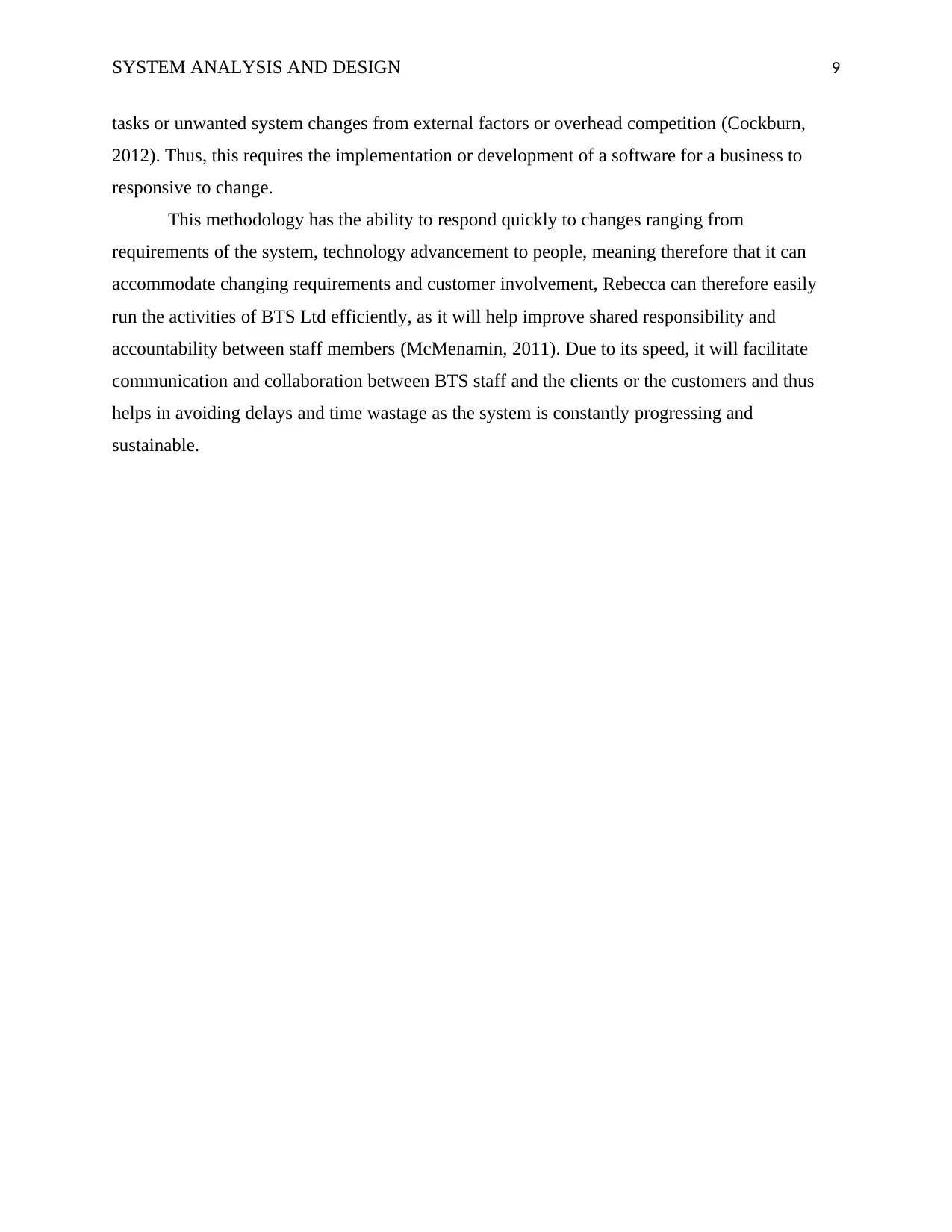
SYSTEM ANALYSIS AND DESIGN 9
tasks or unwanted system changes from external factors or overhead competition (Cockburn,
2012). Thus, this requires the implementation or development of a software for a business to
responsive to change.
This methodology has the ability to respond quickly to changes ranging from
requirements of the system, technology advancement to people, meaning therefore that it can
accommodate changing requirements and customer involvement, Rebecca can therefore easily
run the activities of BTS Ltd efficiently, as it will help improve shared responsibility and
accountability between staff members (McMenamin, 2011). Due to its speed, it will facilitate
communication and collaboration between BTS staff and the clients or the customers and thus
helps in avoiding delays and time wastage as the system is constantly progressing and
sustainable.
tasks or unwanted system changes from external factors or overhead competition (Cockburn,
2012). Thus, this requires the implementation or development of a software for a business to
responsive to change.
This methodology has the ability to respond quickly to changes ranging from
requirements of the system, technology advancement to people, meaning therefore that it can
accommodate changing requirements and customer involvement, Rebecca can therefore easily
run the activities of BTS Ltd efficiently, as it will help improve shared responsibility and
accountability between staff members (McMenamin, 2011). Due to its speed, it will facilitate
communication and collaboration between BTS staff and the clients or the customers and thus
helps in avoiding delays and time wastage as the system is constantly progressing and
sustainable.
⊘ This is a preview!⊘
Do you want full access?
Subscribe today to unlock all pages.

Trusted by 1+ million students worldwide
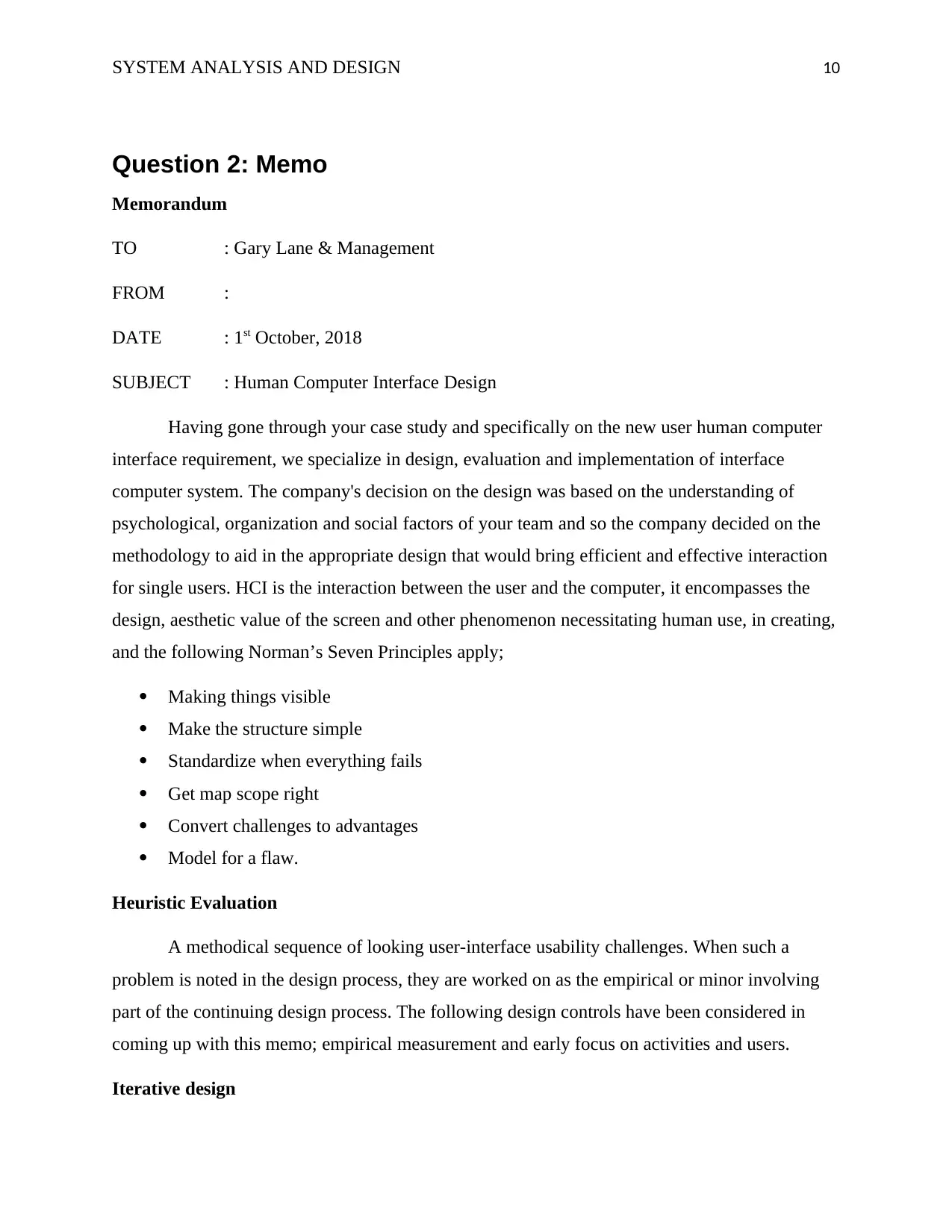
SYSTEM ANALYSIS AND DESIGN 10
Question 2: Memo
Memorandum
TO : Gary Lane & Management
FROM :
DATE : 1st October, 2018
SUBJECT : Human Computer Interface Design
Having gone through your case study and specifically on the new user human computer
interface requirement, we specialize in design, evaluation and implementation of interface
computer system. The company's decision on the design was based on the understanding of
psychological, organization and social factors of your team and so the company decided on the
methodology to aid in the appropriate design that would bring efficient and effective interaction
for single users. HCI is the interaction between the user and the computer, it encompasses the
design, aesthetic value of the screen and other phenomenon necessitating human use, in creating,
and the following Norman’s Seven Principles apply;
Making things visible
Make the structure simple
Standardize when everything fails
Get map scope right
Convert challenges to advantages
Model for a flaw.
Heuristic Evaluation
A methodical sequence of looking user-interface usability challenges. When such a
problem is noted in the design process, they are worked on as the empirical or minor involving
part of the continuing design process. The following design controls have been considered in
coming up with this memo; empirical measurement and early focus on activities and users.
Iterative design
Question 2: Memo
Memorandum
TO : Gary Lane & Management
FROM :
DATE : 1st October, 2018
SUBJECT : Human Computer Interface Design
Having gone through your case study and specifically on the new user human computer
interface requirement, we specialize in design, evaluation and implementation of interface
computer system. The company's decision on the design was based on the understanding of
psychological, organization and social factors of your team and so the company decided on the
methodology to aid in the appropriate design that would bring efficient and effective interaction
for single users. HCI is the interaction between the user and the computer, it encompasses the
design, aesthetic value of the screen and other phenomenon necessitating human use, in creating,
and the following Norman’s Seven Principles apply;
Making things visible
Make the structure simple
Standardize when everything fails
Get map scope right
Convert challenges to advantages
Model for a flaw.
Heuristic Evaluation
A methodical sequence of looking user-interface usability challenges. When such a
problem is noted in the design process, they are worked on as the empirical or minor involving
part of the continuing design process. The following design controls have been considered in
coming up with this memo; empirical measurement and early focus on activities and users.
Iterative design
Paraphrase This Document
Need a fresh take? Get an instant paraphrase of this document with our AI Paraphraser
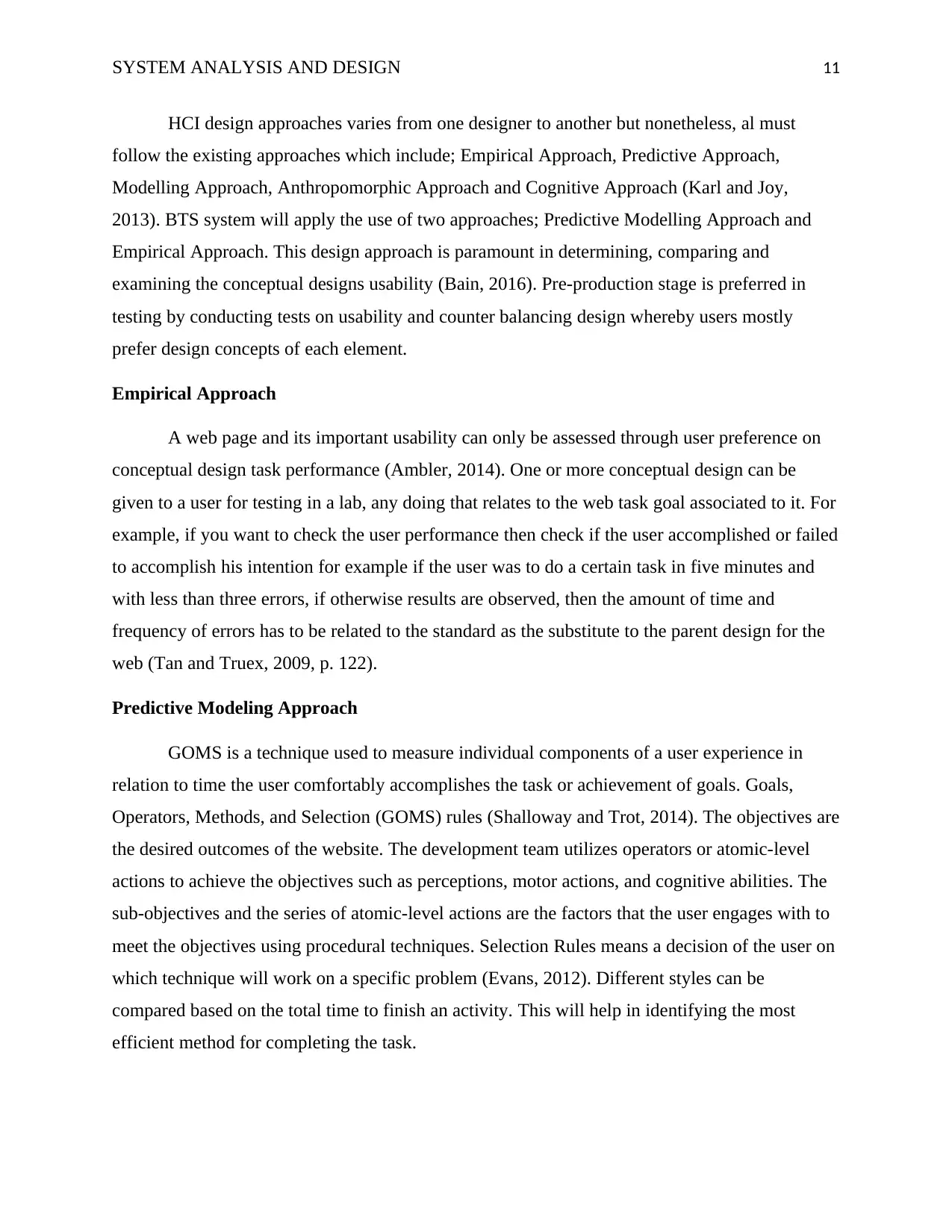
SYSTEM ANALYSIS AND DESIGN 11
HCI design approaches varies from one designer to another but nonetheless, al must
follow the existing approaches which include; Empirical Approach, Predictive Approach,
Modelling Approach, Anthropomorphic Approach and Cognitive Approach (Karl and Joy,
2013). BTS system will apply the use of two approaches; Predictive Modelling Approach and
Empirical Approach. This design approach is paramount in determining, comparing and
examining the conceptual designs usability (Bain, 2016). Pre-production stage is preferred in
testing by conducting tests on usability and counter balancing design whereby users mostly
prefer design concepts of each element.
Empirical Approach
A web page and its important usability can only be assessed through user preference on
conceptual design task performance (Ambler, 2014). One or more conceptual design can be
given to a user for testing in a lab, any doing that relates to the web task goal associated to it. For
example, if you want to check the user performance then check if the user accomplished or failed
to accomplish his intention for example if the user was to do a certain task in five minutes and
with less than three errors, if otherwise results are observed, then the amount of time and
frequency of errors has to be related to the standard as the substitute to the parent design for the
web (Tan and Truex, 2009, p. 122).
Predictive Modeling Approach
GOMS is a technique used to measure individual components of a user experience in
relation to time the user comfortably accomplishes the task or achievement of goals. Goals,
Operators, Methods, and Selection (GOMS) rules (Shalloway and Trot, 2014). The objectives are
the desired outcomes of the website. The development team utilizes operators or atomic-level
actions to achieve the objectives such as perceptions, motor actions, and cognitive abilities. The
sub-objectives and the series of atomic-level actions are the factors that the user engages with to
meet the objectives using procedural techniques. Selection Rules means a decision of the user on
which technique will work on a specific problem (Evans, 2012). Different styles can be
compared based on the total time to finish an activity. This will help in identifying the most
efficient method for completing the task.
HCI design approaches varies from one designer to another but nonetheless, al must
follow the existing approaches which include; Empirical Approach, Predictive Approach,
Modelling Approach, Anthropomorphic Approach and Cognitive Approach (Karl and Joy,
2013). BTS system will apply the use of two approaches; Predictive Modelling Approach and
Empirical Approach. This design approach is paramount in determining, comparing and
examining the conceptual designs usability (Bain, 2016). Pre-production stage is preferred in
testing by conducting tests on usability and counter balancing design whereby users mostly
prefer design concepts of each element.
Empirical Approach
A web page and its important usability can only be assessed through user preference on
conceptual design task performance (Ambler, 2014). One or more conceptual design can be
given to a user for testing in a lab, any doing that relates to the web task goal associated to it. For
example, if you want to check the user performance then check if the user accomplished or failed
to accomplish his intention for example if the user was to do a certain task in five minutes and
with less than three errors, if otherwise results are observed, then the amount of time and
frequency of errors has to be related to the standard as the substitute to the parent design for the
web (Tan and Truex, 2009, p. 122).
Predictive Modeling Approach
GOMS is a technique used to measure individual components of a user experience in
relation to time the user comfortably accomplishes the task or achievement of goals. Goals,
Operators, Methods, and Selection (GOMS) rules (Shalloway and Trot, 2014). The objectives are
the desired outcomes of the website. The development team utilizes operators or atomic-level
actions to achieve the objectives such as perceptions, motor actions, and cognitive abilities. The
sub-objectives and the series of atomic-level actions are the factors that the user engages with to
meet the objectives using procedural techniques. Selection Rules means a decision of the user on
which technique will work on a specific problem (Evans, 2012). Different styles can be
compared based on the total time to finish an activity. This will help in identifying the most
efficient method for completing the task.
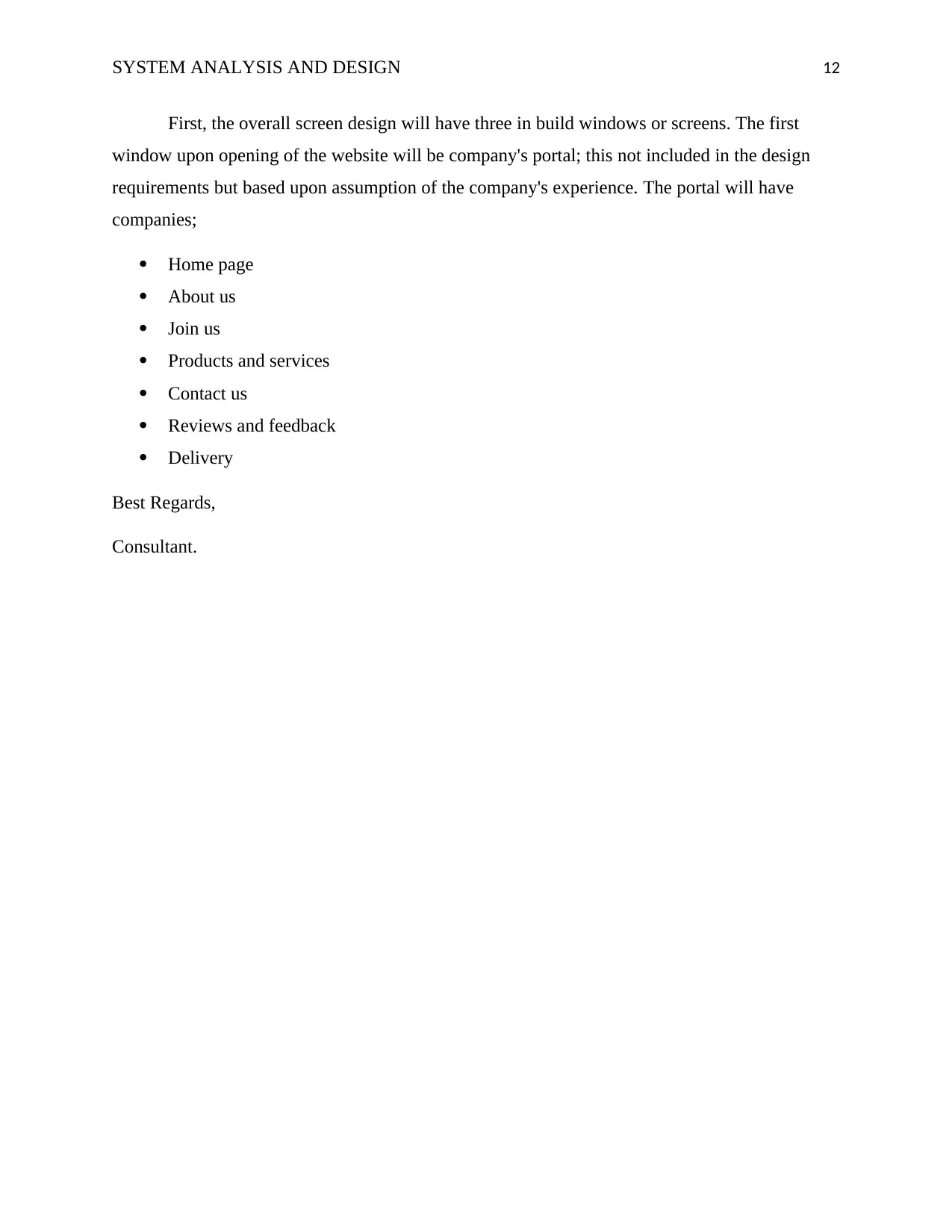
SYSTEM ANALYSIS AND DESIGN 12
First, the overall screen design will have three in build windows or screens. The first
window upon opening of the website will be company's portal; this not included in the design
requirements but based upon assumption of the company's experience. The portal will have
companies;
Home page
About us
Join us
Products and services
Contact us
Reviews and feedback
Delivery
Best Regards,
Consultant.
First, the overall screen design will have three in build windows or screens. The first
window upon opening of the website will be company's portal; this not included in the design
requirements but based upon assumption of the company's experience. The portal will have
companies;
Home page
About us
Join us
Products and services
Contact us
Reviews and feedback
Delivery
Best Regards,
Consultant.
⊘ This is a preview!⊘
Do you want full access?
Subscribe today to unlock all pages.

Trusted by 1+ million students worldwide
1 out of 18
Related Documents
Your All-in-One AI-Powered Toolkit for Academic Success.
+13062052269
info@desklib.com
Available 24*7 on WhatsApp / Email
![[object Object]](/_next/static/media/star-bottom.7253800d.svg)
Unlock your academic potential
Copyright © 2020–2025 A2Z Services. All Rights Reserved. Developed and managed by ZUCOL.


